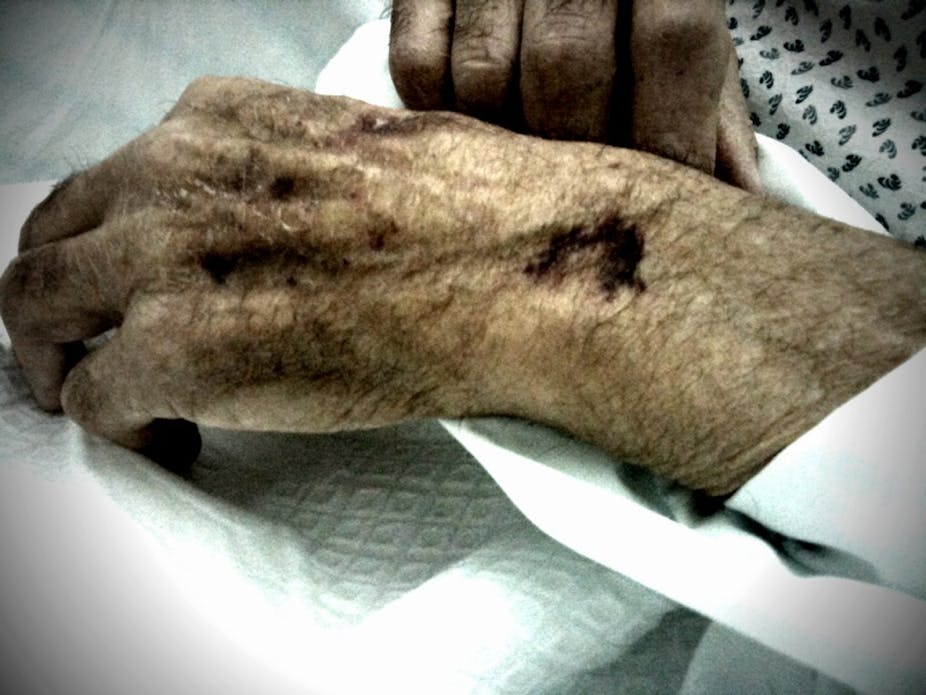Allowing people with incurable and unsupportable illness to die is ethically acceptable to most people, even though it’s unlikely there will ever be unanimity about when and how we allow such deaths.
But as we move into an era of treating chronically ill people with technology that tempts us to try achieve the hopeless, it’s more important than ever that we talk about what kind of death (and life) is acceptable to us – and why.
Treatment is withdrawn or withheld in the expectation of death about 40,000 times a year in Australian hospitals. That’s about 110 people every day, or one every 13 minutes.
These are mostly people with chronic diseases for whom either nothing more can be done (withholding), or for whom more has been done but without success (withdrawal). The overarching ethical concept here is the futility of medical care, which is, at least to some degree, independent of the patient’s own views and wishes.
But sometimes a patient takes the lead role in determining what is futile – as in the recent case of a young man who asked for the mechanical ventilation keeping him alive to be turned off, in full knowledge of the consequences.
JS’ story
According to a newspaper report, JS was quadriplegic and had been dependent on a ventilator since the age of seven. Twenty years on, and with deteriorating health, he had had enough and demanded his ventilator be taken away, saying:
Please give me the control over the care that I receive that every other patient is afforded, and I know is my right.
There was no doubt about his capacity to make such a decision, or about his understanding of the consequences. But a court order was required before the hospital felt safe to honour his demands. But the other 109 people who died of treatment withdrawal that day had no such legal sanction, so what was different about JS?
The medical and nursing staff at the hospital concerned were supportive of his decision, having cared for him for such a long time, and having witnessed his increasing suffering and disability.
Nonetheless, there were concerns that allowing his death by removing life support could be seen as “aiding and abetting suicide” – a criminal offence that could result in imprisonment of the doctors and nurses involved.
But given withdrawal of treatment is not uncommon and that, in JS’ circumstances, it seemed entirely appropriate, was this legal concern even justified? After all, other such cases don’t typically end up in court.
Perhaps there’s a more nuanced interpretation of the situation: members of the Australian community, which includes medical and lay people, have a broad spectrum of comfort zones when it comes to allowing death through medical treatment withdrawal.

So when a case like this “goes public”, there will be at least some people in the hospital and broader community who find the decision to withdraw treatment unsupportable.
There is indeed enormous variation in practice from country to country, hospital to hospital, and doctor to doctor in terms of willingness to withdraw treatment. This ranges from one extreme in Israel, where it’s actually illegal, to Australia and other English-speaking countries, where it’s pretty much the un-discussed norm.
Putting a value on life
A good deal of this variation is associated with religious conviction, often under the umbrella slogan “right to life”. In Australia, this is linked with the notion of “sanctity of life”, a term without explicit Biblical roots but given substance by St Thomas Aquinas in the religious world, and by Immanuel Kant in the secular.
More exactly, it’s about the sanctity of human life rather than all life, since we don’t extend this to dandelions, ants or sheep – although primates are a marginal case in some countries. The more secular expression is the “inviolability of human life”.
Irrespective of whether you approach the issue in religious or secular terms, the inviolability of human life is an enormously important concept in both ethical and legal terms. And it must be distinguished from a “vitalist” stance, which is a purely religious notion without a secular (ethical) equivalent that considers all human life to be of infinite worth without heed to the quality of that life.

This claim is based on the belief that we don’t own our lives or bodies as they are gifts from god. So we’re not empowered to make end-of-life decisions other than those that require we be actively treated until our last breath.
The vitalist stance is inconsistent with humane and ethical care for those approaching the end of their life in the modern era, where chronically ill patients are exposed to technological interventions that may not serve them well.
And it stands in contrast to the sanctity of human life position, which not only allows for, but encourages a judicious use of life-prolonging treatments at the end of life. If human life is inviolable, we are charged with the responsibility to ease its end, not to prolong it mercilessly.
Clearly, the inviolability (or sanctity) of human life is a crucial notion for equity in health care, strongly linked to treating those with disability and misfortune fairly. But while we must try to understand vitalist views, it’s essential that we don’t confuse the two.
It’s perfectly consistent to respect the inviolability of human life and withdraw treatment in the expectation of death; we can’t question the value of a human life, but we must sometimes question the value of continuing medical treatment, just as JS did.

